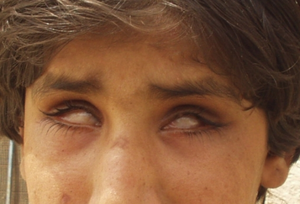Aphakia
| Aphakia | |
|---|---|
 | |
| Individual showing complete congenital primary aphakia. | |
| Specialty | Ophthalmology |
Aphakia is the absence of the lens of the eye, due to surgical removal, such as in cataract surgery, a perforating wound or ulcer, or congenital anomaly. It causes a loss of accommodation, high degree of farsightedness (hyperopia),[1] and a deep anterior chamber. Complications include detachment of the vitreous or retina, and glaucoma.
Babies are rarely born with aphakia. Occurrence most often results from surgery to remove congenital cataract. Congenital cataracts usually develop as a result of infection of the fetus or genetic reasons. It is often difficult to identify the exact cause of these cataracts, especially if only one eye is affected.
People with aphakia have relatively small pupils and their pupils dilate to a lesser degree.[2]
Signs and symptoms
- Hypermetropia: Without the focusing power of the lens, the eye becomes very farsighted.
- Loss of accommodation: Since the lens and its zonules are responsible for adjusting the focus of vision to different lengths, patients with aphakia will have a total loss of accommodation.
- Defective vision: High degree hypermetropia and total loss of accommodation cause defective vision for both distance and near.
- Cyanopsia: Absence of lens cause cyanopsia or blue vision.[1] Some individuals have said that they perceive ultraviolet light, invisible to those with a lens, as whitish blue or whitish-violet.[3][4]
- Erythropsia: Sometimes, objects appear reddish.[1]
- Deep anterior chamber: Since lens is absent, anterior chamber will be deep.
- Iridodonesis:[1] Iridodonesis is the vibration or agitated motion of the iris with eye movement.
- Purkinje test shows only two images; the reflection from anterior and posterior corneal surfaces.[1]
- Iridectomy mark may be seen in surgical aphakia.[5]
- Astigmatism: With-the-rule astigmatism due to corneal wound healing may occur in surgical aphakia, mainly after ICCE or ECCE.[5]
Complications
Main complications of surgical aphakia include:
- Spectacle intolerance: Due to image magnification (up to 30%), optical aberration, prismatic effect and roving ring scotoma, spectacles are not well tolerated by aphakic patients.[6] Due to high anisometropia, spectacle correction in uniocular aphakia may cause diplopia.[6]
- Glaucoma: Secondary angle closure glaucoma may occur due to vitreous prolapse.[7]
- Retinal detachment[8]
- Aphakic bullous keratopathy[6]
Causes
Surgical removal of a lens, mainly in cataract surgery, is the most common cause of aphakia.[1] Spontaneous traumatic absorption or congenital absence of lens matter is rare.[9][10] Traumatic subluxation or dislocation of a lens may cause it.[1]
Diagnosis
The diagnosis of Aphakia in a individual suspected of having it, can be done via a slit lamp[11]
Treatment
Aphakia can be corrected by wearing glasses, contact lenses, artificial lens implantation, or refractive corneal surgeries.[1] Eye with artificial lenses are described as "pseudophakic".
Etymology
Gr. a- alfa priv + phakos, lens, anything shaped like a lens[12]
References
- ↑ 1.0 1.1 1.2 1.3 1.4 1.5 1.6 1.7 Khurana, AK (2015). "Errors of refraction and accommodation". Comprehensive ophthalmology (6th ed.). Jaypee, The Health Sciences Publisher. pp. 37–38. ISBN 978-93-86056-59-7.
- ↑ Mary V Gibbens; R Goel; S E Smith (1989). "Effect of cataract extraction on the pupil response to mydriatics". British Journal of Ophthalmology. 73 (7): 563–565. doi:10.1136/bjo.73.7.563. PMC 1041802. PMID 2757997.
- ↑ R M Anderson (1983). "Visual perceptions and observations of an aphakic surgeon". Perceptual and Motor Skills. 57 (3_suppl): 1211–1218. doi:10.2466/pms.1983.57.3f.1211. PMID 6664798. S2CID 20005737.
- ↑ David Hambling (29 May 2002). "Let the light shine in". The Guardian. Archived from the original on 8 July 2018. Retrieved 31 March 2022.
- ↑ 5.0 5.1 Textbook of ophthalmology Vol 1. Agarwal, Sunita. New Delhi, India: Jaypee Bros. Medical Publishers. 2002. ISBN 978-81-7179-884-1. OCLC 49561947. Archived from the original on 2020-07-07. Retrieved 2022-03-31.
{{cite book}}: CS1 maint: others (link) - ↑ 6.0 6.1 6.2 Ramanjit, Sihota; Radhika, Tandon (2015). Parsons' diseases of the eye (22nd ed.). New Delhi, India: Elsevier. ISBN 978-81-312-3819-6. OCLC 905915528.
- ↑ Sowka, Joseph W. (November 2002). "Pupil block glaucoma from traumatic vitreous prolapse in a patient with posterior chamber lens implantation". Optometry (St. Louis, Mo.). 73 (11): 685–693. ISSN 1529-1839. PMID 12516797. Archived from the original on 2022-06-18. Retrieved 2022-03-31.
- ↑ Ophthalmology. Yanoff, Myron,, Duker, Jay S., 1958- (5th ed.). Edinburgh: Elsevier. 2019. ISBN 978-0-323-52821-4. OCLC 1051774434.
{{cite book}}: CS1 maint: others (link) - ↑ Alpar, John (1 April 1989). ""Present state of management of aphakia. Future of spectacles and contact lenses"". Indian Journal of Ophthalmology. 37 (2): 54–57. ISSN 0301-4738. PMID 2583777. Archived from the original on 17 May 2022. Retrieved 31 March 2022.
- ↑ "Congenital primary aphakia". rarediseases.info.nih.gov. Archived from the original on 2022-05-17. Retrieved 2022-03-31.
- ↑ "What Is Aphakia?". American Academy of Ophthalmology. 10 December 2021. Archived from the original on 20 March 2022. Retrieved 23 July 2022.
- ↑ aphakia. (n.d.) Farlex Partner Medical Dictionary. (2012). Retrieved April 13, 2016 from http://medical-dictionary.thefreedictionary.com/aphakia Archived 2020-11-27 at the Wayback Machine Archived 2020-11-27 at the Wayback Machine
External links
| Classification |
|---|